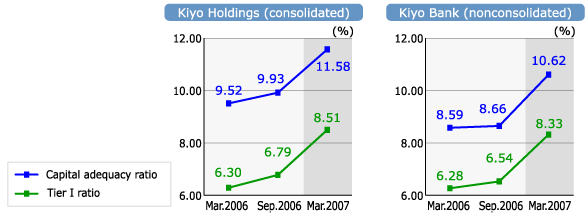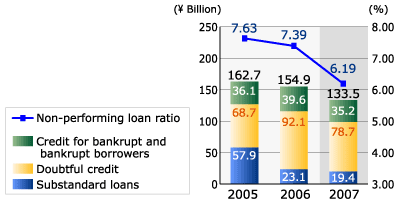
 |
Contents
|
The Year in Review In the first half of the year under review, Wakayama Bank’s business volume decreased in the face of drastic branch streamlining in preparation for the merger of Wakayama Bank with Kiyo Bank. The new Kiyo Bank (“the Bank”), formed in October 2006 as a result of the merger, concentrated on increasing loans to small and medium-sized enterprises (SMEs) and attracting deposits from SMEs, as well as on expanding fees and commissions. These steps were part of the Bank’s efforts under its first medium-term business plan, which was launched to coincide with the merger. As a result of these steps, loans and deposits both showed greater than projected increases, and commissions from the sale of investment trusts and other fees also grew steadily. Additionally, due to factors such as the gradual appearance of encouraging signs in the regional economy, total credit expenses decreased, partially owing to gains on the recovery of written-off loans (including recoveries of write-offs). Deposits and LoansBoth the balance of deposits and the balance of loans and bills discounted decreased prior to October 2006, reflecting the fact that the former Wakayama Bank was facing drastic branch streamlining, but began to increase again after the merger. In the six months from the end of September 2006, deposits increased by ¥169.4 billion, and loans and bills discounted increased by ¥98.7 billion. Deposits
Loans and Bills Discounted
Capital RatioThe Group’s capital ratio (domestic standard) rose 2.06 percentage points from the previous year to 11.58% on a consolidated basis, reflecting a year-on-year increase in equity capital of ¥40 billion (Tier I: ¥39.7 billion). This is largely attributable to the fact that the Group recorded net income for the year and received an injection of public funds.  Deferred tax assets of Kiyo Holdings decreased by ¥4.2 billion year-on-year on a consolidated basis. Deferred tax assets of Kiyo Bank decreased by ¥1.4 billion on a nonconsolidated basis.
Non-Performing Loans (Loans Disclosed under the Financial Reconstruction Law)With the aim of bringing the non-performing loan ratio down to less than 5% by the year ending March 2009, the Bank worked to accelerate the disposal of non-performing loans so as to bring the ratio down to the normal level. This included improving customers’ debtor categories through involvement in support for business reconstruction and management improvement.  Coverage of Non-Performing Loans
|
|||||||||||||||||||||||||||||||||
|
Copyright © 2007 Kiyo Holdings, Inc. All reserved. |